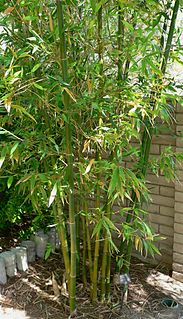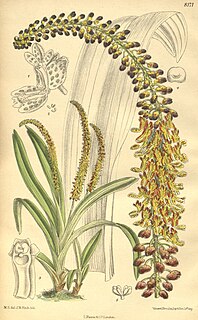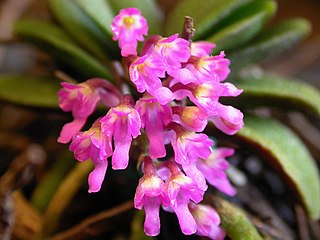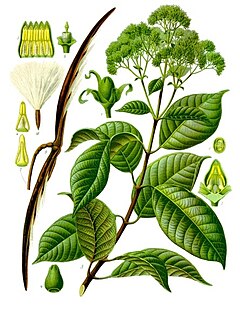
Bambusa is a large genus of clumping bamboos.

Dendrocalamus is a tropical Asian genus of giant clumping bamboos in the grass family. It is found in the Indian subcontinent, China, and Southeast Asia.

Salacca is a genus of about 20 species of palms native to Southeast Asia and the eastern Himalayas.

Arisaema is a large and diverse genus of the flowering plant family Araceae. The largest concentration of species is in China and Japan, with other species native to other parts of southern Asia as well as eastern and central Africa, Mexico and eastern North America. Asiatic species are often called cobra lilies, while western species are often called jack-in-the-pulpit; both names refer to the distinctive appearance of the flower, which consists of an erect central spadix rising from a spathe.

Livistona is a genus of palms, native to southern, southeastern and eastern Asia, Australasia, and the Horn of Africa. They are fan palms, the leaves with an armed petiole terminating in a rounded, costapalmate fan of numerous leaflets.

Tainia, commonly known as ribbon orchids or 带唇兰属 is a genus of about thirty species of evergreen, terrestrial orchids in the distributed from India, China, Japan, Southeast Asia to New Guinea, the Solomon Islands and Queensland.

Daemonorops is a genus of rattan palms in the family Arecaceae found primarily in the tropics and subtropics of southeastern Asia with a few species extending into southern China and the Himalayas.

Arenga is a genus of palms, native to Southeast Asia, southern China, New Guinea, and northern Australia. They are small to medium-sized palms, growing to 2–20 m tall, with pinnate leaves 2–12 m long. Arenga palms can grow in areas with little sunlight and relatively infertile soil.

Wallichia is a genus of seven species of flowering plant in the family Arecaceae. The genus is distributed in the Eastern Himalayas, northern Indochina, and southern China.
Callostylis is a genus of orchids. It was previously considered as a synonym of the genus Eria, but eventually it has become an accepted name. It is native to Southeast Asia from Assam and southern China to Java.

Mycaranthes is a genus of orchids. It was previously considered as a synonym of the genus Eria, but eventually it has become an accepted name. Its species are native to Southeast Asia, China, the Himalayas and New Guinea.
- M. anceps(Leav.) Cootes & W.Suarez - Palawan, Negros
- M. candoonensis(Ames) Cootes & W.Suarez - Mindanao
- M. citrina(Ridl.) Rauschert - Palawan, Borneo, Peninsular Malaysia
- M. clemensiae(Leav.) Cootes & W.Suarez - Philippines
- M. davaensis(Ames) Cootes & W.Suarez - Mindanao
- M. depauperataJ.J.Wood - Sabah
- Mycaranthes floribunda(D.Don) S.C.Chen & J.J.Wood - Yunnan, Assam, Bangladesh, Bhutan, Nepal, Myanmar, Thailand, Laos, Vietnam, Cambodia, Malaysia, Borneo
- M. forbesiana(Kraenzl.) Rauschert - Sumatra
- M. gigantea(Ames) Cootes & W.Suarez - Philippines
- M. hawkesii(A.H.Heller) Rauschert - New Guinea
- M. lamellata(Ames) Cootes & W.Suarez - Leyte, Mindanao
- M. latifoliaBlume - Indonesia, Malaysia
- M. leucotricha(Schltr.) Rauschert - New Guinea
- M. lobataBlume - Indonesia
- M. longibracteata(Leav.) Cootes & W.Suarez - Philippines#
- Mycaranthes magnicallosa(Ames & C.Schweinf.) J.J.Wood - Sabah
- Mycaranthes major(Ridl.) J.J.Wood - Borneo, Maluku, Philippines
- Mycaranthes melaleuca(Ridl.) J.J.Wood - Borneo
- Mycaranthes meliganensisJ.J.Wood - Sabah
- M. merguensis(Lindl.) Rauschert - Myanmar, Thailand
- M. mindanaensis(Ames) Cootes & W.Suarez - Capiz, Sibuyan
- M. monostachya(Lindl.) Rauschert - Java, Sumatra
- M. nieuwenhuisii(J.J.Sm.) Rauschert - Borneo
- M. obliquaLindl. - Borneo, Malaysia, Sumatra
- M. oblitterataBlume -Thailand, Vietnam, Cambodia, Malaysia, Java, Borneo, Sumatra, Bali
- M. padangensis(Schltr.) Brieger - Sumatra
- Mycaranthes pannea(Lindl.) S.C.Chen & J.J.Wood - Guangxi, Guizhou, Hainan, Tibet, Yunnan, Bhutan, Cambodia, India, Assam, Borneo, Sumatra, Laos, Malaysia, Myanmar, Singapore, Thailand, Vietnam
- M. rhinoceros(Ridl.) Rauschert - Sumatra
- M. schistoloba(Schltr.) Rauschert - Sumatra
- M. sonkaris(Rchb.f.) Rauschert - Sumatra, Borneo, Sumbawa
- M. stenophylla(Schltr.) Rauschert - New Guinea
- M. tjadasmalangensis(J.J.Sm.) Rauschert - Java, Sumatra
- M. tricuspidata(Rolfe) Rauschert - Sulawesi
- M. vanoverberghii(Ames) Cootes, D.P.Banks & W.Suarez - Philippines

Homalomena is a genus of flowering plants within the family Araceae. Homalomena are primarily found in southern Asia and the southwestern Pacific, but there are a few species that are known to be indigenous to Latin America. Many Homalomena have a strong smell of anise. The name derives apparently from a mistranslated Malayan vernacular name, translated as homalos, meaning flat, and mene = moon.

Pholidota, commonly known as rattlesnake orchids, is a genus of flowering plants from the orchid family, Orchidaceae. Plants in this genus are clump-forming epiphytes or lithophytes with pseudobulbs, each with a single large leaf and a large number of small, whitish flowers arranged in two ranks along a thin, wiry flowering stem that emerges from the top of the pseudobulb. There are about thirty five species native to areas from tropical and subtropical Asia to the southwestern Pacific.

Thelasis, commonly known as fly orchids, is a genus of flowering plants from the orchid family, Orchidaceae. Plants in this genus are usually epiphytes, sometimes lithophytes or rarely terrestrials. Some species have pseudobulbs with up to three leaves, whilst others have several leaves in two ranks. A large number of small, white or greenish yellow flowers are borne on a thin, arching flowering stem. There are about thirty species, distributed from tropical and subtropical Asia to the southwest Pacific.

Micropera, commonly known as dismal orchids or 小囊兰属 is a genus of about twenty species of flowering plants from the orchid family, Orchidaceae. Plants in this genus are large epiphytes with thick roots, long, fibrous stems, linear leaves and whitish or yellow, non-resupinate flowers. The sepals and petals are similar to each other and the labellum is shoe-shaped or sac-like and has three lobes. It is found from Tibet to tropical Asia and the western Pacific Ocean.

Schoenorchis, commonly known as flea orchids, or 匙唇兰属 , is a genus of flowering plants from the orchid family, Orchidaceae. Plants in this genus are small epiphytes with thin roots, thin leafy stems with leaves in two ranks and tiny fragrant, almost tube-shaped flowers with a prominently spurred labellum. There are about twenty five species found from tropical and subtropical Asia to the Western Pacific.

Urceola is a plant genus in the family Apocynaceae, first described as a genus in 1798. It is native to China, the Himalayas, Southeast Asia, and New Guinea.
- Urceola brachysepalaHook.f. - Borneo, Java, W Malaysia, Sumatra, Philippines
- Urceola elasticaRoxb. - Borneo, Java, W Malaysia, Sumatra
- Urceola huaitingii(Chun & Tsiang) Mabb. - Guizhou, Guangdong, Guangxi, Hainan
- Urceola javanica(Blume) Boerl. - Borneo, Java, Maluku, Sumatra, Sulawesi, New Guinea
- Urceola laevis(Elmer) Merr. - Palawan, Sabah, Sulawesi
- Urceola lakhimpurensis(S.K.Srivast. & Mehrotra) Karthik. & Moorthy - Assam
- Urceola latifolia(Pierre ex Spire) Mabb. - Laos, Thailand, Vietnam
- Urceola lucida(A.DC.) Benth. ex Kurz - Myanmar, Thailand, W Malaysia, Sumatra
- Urceola malayanaMabb. - Cameron Highlands of W Malaysia
- Urceola micrantha(Wall. ex G.Don) Mabb. - Fujian, Guangdong, Guangxi, Hainan, Sichuan, Taiwan, Tibet, Yunnan, Ryukyu Islands, Assam, Bangladesh, Bhutan, Arunachal Pradesh, Nepal, Cambodia, Laos, Thailand, Vietnam, Myanmar, W Malaysia
- Urceola minutiflora(Pierre) Mabb. - Cambodia, Laos, Thailand, Vietnam
- Urceola napeensis(Quint.) Mabb. - Laos, Thailand, Vietnam, Guangdong, Guangxi
- Urceola quintaretii(Pierre) Mabb. - Laos, Vietnam, Guangdong, Guangxi
- Urceola rosea(Hook. & Arn.) D.J.Middleton - Cambodia, Laos, Thailand, Vietnam, Laos, W Malaysia, Java, Sumatra, Fujian, Guangdong, Guangxi, Guizhou, Hainan, Hunan, Sichuan, Taiwan, Yunnan
- Urceola torulosaHook.f. - W Malaysia, Sumatra, Borneo
- Urceola tournieri(Pierre) Mabb. - Yunnan, Nepal, Bhutan, Assam, Laos, Myanmar, Thailand, Vietnam
- Urceola xylinabariopsoides(Tsiang) Mabb. - Hainan, Vietnam
Hornstedtia is a genus of plants in the Zingiberaceae. It is native to Southeast Asia, the Himalayas, southern China, New Guinea, Melanesia and Queensland.

Globba is a genus of plants in the ginger family. It contains about 100 species, native to China, the Indian Subcontinent, Southeast Asia, New Guinea, the Bismarck Archipelago and Queensland.
Gomphostemma is a genus of flowering plants in the mint family, Lamiaceae, first described in 1830. It is native to Southeast Asia, China, and the Indian subcontinent.
- Gomphostemma aborensisDunn - Arunachal Pradesh
- Gomphostemma arbusculumC.Y.Wu - Yunnan
- Gomphostemma callicarpoides(Yamam.) Masam. - Taiwan
- Gomphostemma chinenseOliv. - Fujian, Guangdong, Guangxi, Hainan, Jiangxi, Vietnam
- Gomphostemma crinitumWall. ex Benth. - Indochina, Yunnan, Assam, Bangladesh
- Gomphostemma curtisiiPrain - Malaya, Sumatra, Borneo
- Gomphostemma deltodonC.Y.Wu - Yunnan
- Gomphostemma dolichobotrysMerr. - Sumatra
- Gomphostemma eriocarpumBenth. - southern India
- Gomphostemma grandiflorumDoan ex Suddee & A.J.Paton - Vietnam
- Gomphostemma hainanenseC.Y.Wu - Hainan
- Gomphostemma hemsleyanumPrain ex Collett & Hemsl. - Java, Myanmar
- Gomphostemma heyneanumWall. ex Benth. - southern India
- Gomphostemma hirsutumWalsingham - Sabah
- Gomphostemma inopinatumPrain - Myanmar
- Gomphostemma javanicum(Blume) Benth. - Indochina, Andaman Islands, Borneo, Sumatra, Java, Sulawesi, Bali, Lombok, Timor, Philippines
- Gomphostemma keralensisVivek., Gopalan & R.Ansari. - Kerala
- Gomphostemma laceiMukerjee - Myanmar
- Gomphostemma latifoliumC.Y.Wu - Yunnan, Guangdong
- Gomphostemma leptodonDunn - Guangxi, Vietnam
- Gomphostemma lucidumWall. ex Benth. - Indochina, Assam, Bangladesh, Guangdong, Guangxi, Yunnan
- Gomphostemma mastersiiBenth. ex Hook.f. - Assam, Bangladesh, Thailand
- Gomphostemma melissifoliumWall. ex Benth. - Assam, Bangladesh, Bhutan, Nepal
- Gomphostemma microcalyxPrain - Borneo, Malaya, Sumatra
- Gomphostemma microdonDunn - Yunnan, Laos, Thailand, Vietnam
- Gomphostemma nayariiA.S.Chauhan - Assam
- Gomphostemma niveumHook.f. - Assam, Arunachal Pradesh, Vietnam
- Gomphostemma nutansHook.f. - Assam, Myanmar
- Gomphostemma ovatumWall. ex Benth. - Assam, Bangladesh, Bhutan, Nepal
- Gomphostemma parviflorumWall. ex Benth. - Assam, Bangladesh, Bhutan, Nepal, Yunnan, Indochina, Borneo, Java, Sumatra
- Gomphostemma pedunculatumBenth. ex Hook.f. - Assam, Yunnan, Vietnam
- Gomphostemma pseudocrinitumC.Y.Wu - Guangxi
- Gomphostemma salarkhanianumKhanam & M.A.Hassan - Sylhet District in Bangladesh
- Gomphostemma scortechiniiPrain - Myanmar, Thailand, Malaya
- Gomphostemma stellatohirsutumC.Y.Wu - Yunnan
- Gomphostemma strobilinum Wall. ex Benth. - Bangladesh, Myanmar, Thailand, Vietnam
- Gomphostemma sulcatumC.Y.Wu - Yunnan
- Gomphostemma thomsoniiBenth. ex Hook.f. - Assam
- Gomphostemma velutinumBenth. - Assam, Bangladesh
- Gomphostemma wallichiiPrain - Assam, Myanmar, Thailand


















